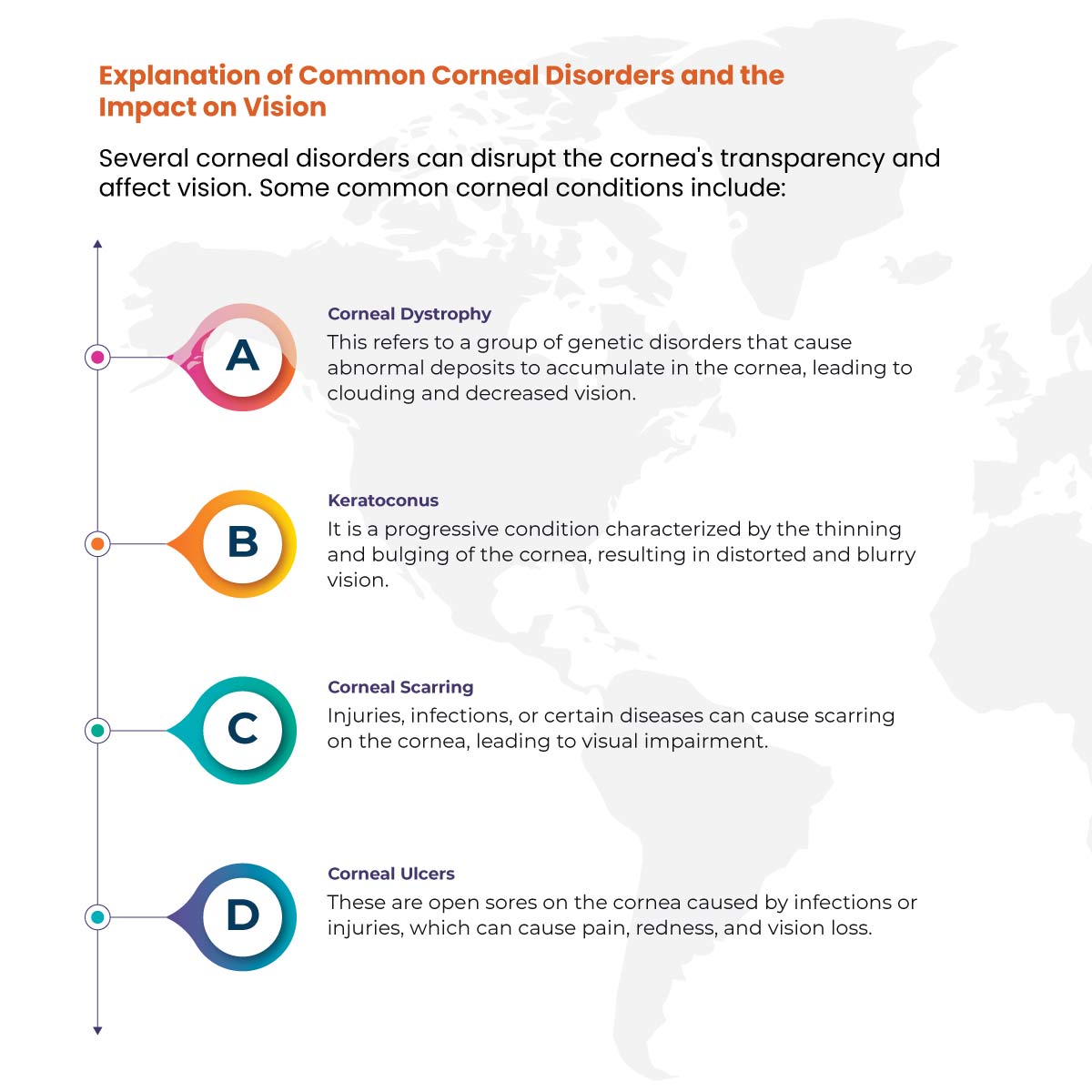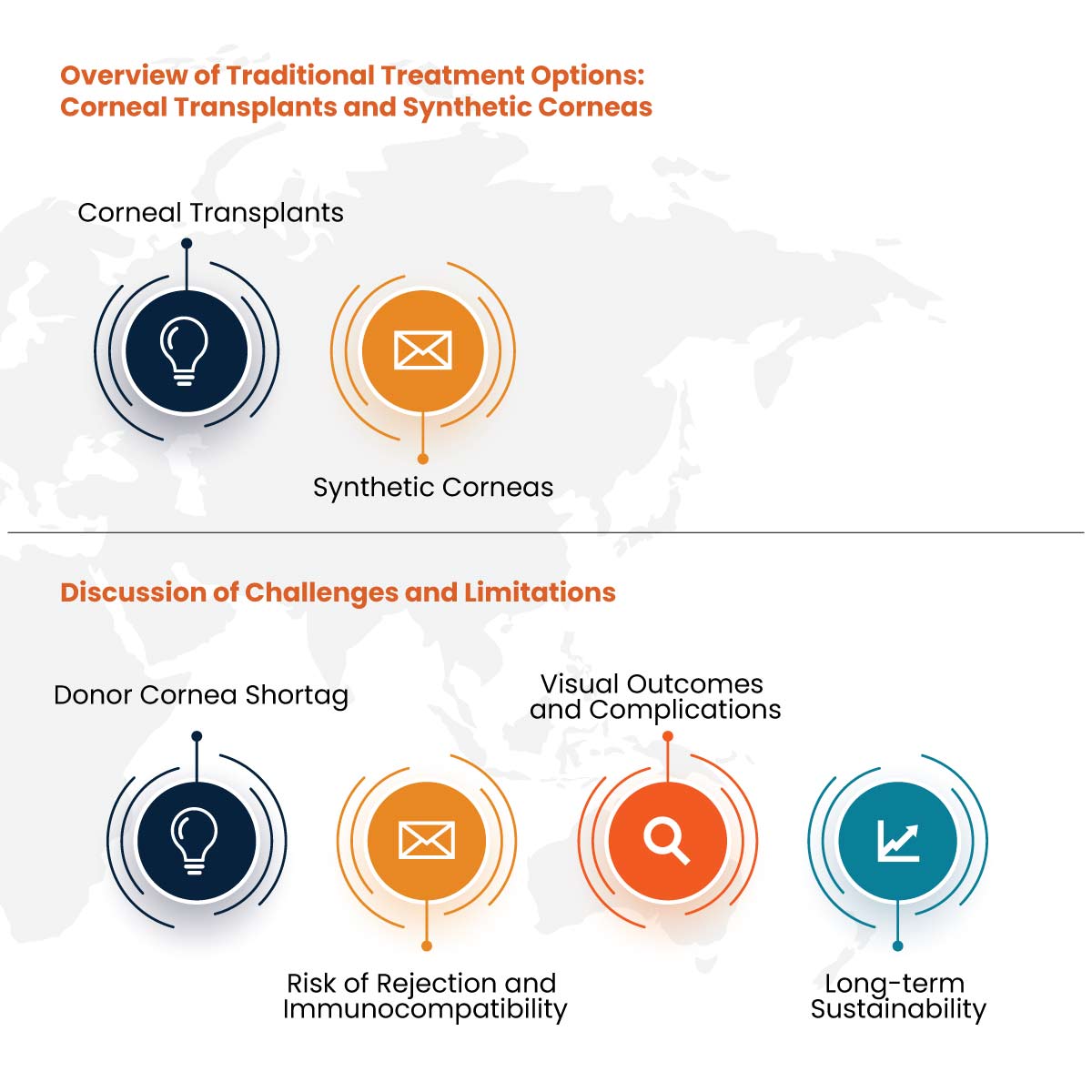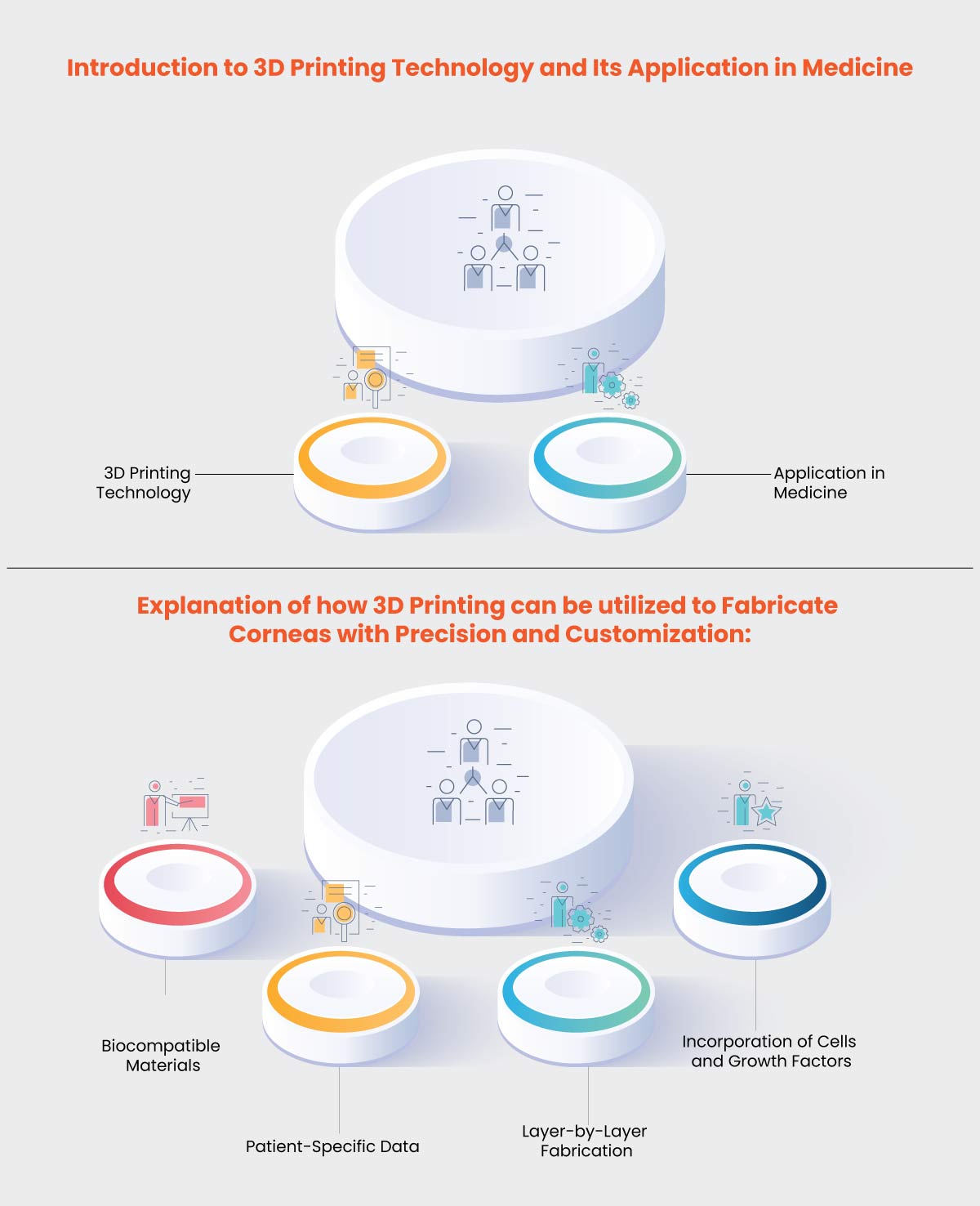The field of regenerative medicine has witnessed groundbreaking advancements in recent years, revolutionizing the possibilities for restoring vision in individuals with corneal disorders. Among these cutting-edge developments, 3D printing technology has emerged as a promising solution for creating artificial corneas.
The ability to fabricate customized corneas using biocompatible materials and patient-specific data brings new hope to those suffering from corneal damage or diseases that lead to vision impairment. In this blog post, we will explore the exciting potential of 3D printed corneas in vision restoration and how this innovative approach is reshaping the landscape of ophthalmology. In this blog, we will discuss the following key points:
Understanding the Cornea:
- Introduction to the cornea and its crucial role in vision
- Explanation of common corneal disorders and the impact on vision
Limitations of Traditional Treatments:
- Overview of traditional treatment options such as corneal transplants and synthetic corneas
- Discussion of the challenges and limitations associated with these approaches
Enter 3D Printing Technology:
- Introduction to 3D printing technology and its application in medicine
- Explanation of how 3D printing can be utilized to fabricate corneas with precision and customization
Advantages of 3D Printed Corneas:
- Discussion of the benefits offered by 3D printed corneas, including improved biocompatibility and reduced rejection rates
Current Progress and Future Prospects:
- Overview of the latest research and advancements in 3D printed corneas
- Exploration of the challenges that need to be addressed for widespread adoption
- Insight into the future possibilities and impact of 3D printed corneas on vision restoration
By delving into the fascinating world of 3D printed corneas, we can better understand the transformative potential of this technology and its role in shaping the future of vision restoration.
The corneal ulcer treatment market has witnessed substantial growth in recent years, with a projected rapid expansion. Traditional drug therapies used to treat corneal ulcers often lead to corneal scarring and impaired vision. In response to these challenges, manufacturers have introduced innovative and alternative approaches, including dual therapy involving combinations of drugs. These advancements are expected to drive the growth of the corneal ulcer treatment market. According to the analysis conducted by Data Bridge Market Research, the market for corneal ulcer treatment is projected to grow at a Compound Annual Growth Rate (CAGR) of 6.50% from 2022 to 2029. This signifies the increasing demand for effective and improved treatment options to address corneal ulcers and the potential for significant advancements in this field.
To learn more about the study, visit: https://www.databridgemarketresearch.com/reports/global-corneal-ulcer-treatment-market
- Understanding the Cornea
The cornea is a vital component of the human eye, serving as the transparent outermost layer that covers the front surface. It plays a crucial role in focusing light onto the retina, enabling clear vision. However, various corneal disorders can significantly impact its function, leading to vision impairment. This section aims to provide a comprehensive understanding of the cornea and the implications of corneal disorders on vision.
Introduction to the Cornea and Its Crucial Role in Vision
The cornea acts as a protective barrier for the eye, shielding it from external elements and serving as the eye's first line of defense. It refracts light as it enters the eye, bending it towards the lens, which further focuses the light onto the retina. This process facilitates the formation of a clear and sharp image.
Fig.1: Common corneal disorders
Explanation of Common Corneal Disorders and the Impact on Vision
Several corneal disorders can disrupt the cornea's transparency and affect vision. Some common corneal conditions include:
- Corneal Dystrophy: This refers to a group of genetic disorders that cause abnormal deposits to accumulate in the cornea, leading to clouding and decreased vision.
- Keratoconus: It is a progressive condition characterized by the thinning and bulging of the cornea, resulting in distorted and blurry vision.
- Corneal Scarring: Injuries, infections, or certain diseases can cause scarring on the cornea, leading to visual impairment.
- Corneal Ulcers: These are open sores on the cornea caused by infections or injuries, which can cause pain, redness, and vision loss.
Understanding these corneal disorders is crucial to appreciate the significance of 3D printed corneas as a potential solution for vision restoration. By exploring the limitations of traditional treatments in the subsequent section, we can further appreciate the need for innovative approaches such as 3D printing technology in the field of ophthalmology.
- Limitations of Traditional Treatments
While various treatment options exist for corneal disorders, including corneal transplants and synthetic corneas, they come with certain limitations that have prompted the search for alternative approaches. This section aims to provide an overview of traditional treatment methods and shed light on their challenges and drawbacks.
Fig.2: Limitations of traditional eye treatments
Overview of Traditional Treatment Options: Corneal Transplants and Synthetic Corneas
- Corneal Transplants: Corneal transplantation, or keratoplasty, involves replacing a damaged or diseased cornea with a healthy cornea from a donor. Although this procedure has been successful in restoring vision for many patients, there are limitations, such as a limited supply of donor corneas, the risk of rejection, and the need for lifelong immunosuppressive medications.
- Synthetic Corneas: Synthetic corneas, also known as keratoprostheses, are artificial corneas designed to replace damaged tissue. These prosthetic devices are typically made of non-biological materials and can be implanted into the eye. However, they often have limited visual outcomes and can still face issues such as inflammation, infection, and mechanical complications.
Discussion of Challenges and Limitations
- Donor Cornea Shortage: The availability of suitable donor corneas is a significant limitation in corneal transplants, leading to long waiting lists and delays in treatment.
- Risk of Rejection and Immunocompatibility: Corneal transplants carry a risk of rejection, as the recipient's immune system may identify the transplanted cornea as foreign. This necessitates the use of immunosuppressive medications, which can have side effects and require ongoing management.
- Visual Outcomes and Complications: Both corneal transplants and synthetic corneas may not provide optimal visual outcomes due to factors such as irregular astigmatism, corneal haze, and complications associated with the prosthetic device.
- Long-term Sustainability: Traditional treatments may require additional surgeries or interventions over time due to complications or the natural degradation of the transplanted or synthetic cornea.
Understanding the limitations and challenges associated with traditional treatment options highlights the need for innovative approaches like 3D printed corneas. In the subsequent sections, we will delve into the potential of 3D printing technology to overcome these limitations and provide new hope for vision restoration.
- Enter 3D Printing Technology
The emergence of 3D printing technology has opened up new possibilities in the field of medicine, including the fabrication of custom-made corneas. This section aims to introduce the concept of 3D printing and its application in creating artificial corneas, highlighting the potential advantages of this innovative approach.
Fig.3: 3D printing technology in context to vision restoration
Introduction to 3D Printing Technology and Its Application in Medicine
- 3D Printing Technology: 3D printing, also known as additive manufacturing, is a process of creating three-dimensional objects by layering materials based on a digital model. It has gained significant attention in various industries due to its ability to fabricate complex structures with precision.
- Application in Medicine: 3D printing technology has found numerous applications in the field of medicine, including the production of medical implants, prosthetics, surgical models, and customized medical devices. Its capability to generate patient-specific designs makes it particularly valuable in personalized healthcare.
Explanation of how 3D Printing can be utilized to Fabricate Corneas with Precision and Customization:
- Biocompatible Materials: 3D printing enables the use of biocompatible materials, such as synthetic polymers or bio inks, which are compatible with the human body and can be safely implanted.
- Patient-Specific Data: With 3D printing, corneas can be fabricated based on individual patient data, such as corneal topography and dimensions, ensuring a precise fit and better visual outcomes.
- Layer-by-Layer Fabrication: 3D printers build corneas layer by layer, allowing for intricate structures and customized designs. This technique can mimic the complex microarchitecture of the natural cornea, enhancing biocompatibility and functionality.
- Incorporation of Cells and Growth Factors: 3D printing techniques also enable the incorporation of cells and growth factors within the printed corneas, promoting tissue integration and regeneration.
By harnessing the potential of 3D printing technology, researchers and clinicians are exploring the feasibility of fabricating corneas that overcome the limitations of traditional treatments. In the subsequent section, we will delve into the advantages offered by 3D printed corneas and their potential impact on vision restoration.
- Advantages of 3D Printed Corneas
The utilization of 3D printing technology in fabricating corneas brings forth several advantages compared to traditional treatment options. This section aims to discuss the benefits offered by 3D printed corneas, highlighting their improved biocompatibility, reduced rejection rates, and potential for personalized implants.
Fig.4: Benefits of 3D printed corneas
Discussion of the Benefits of 3D Printed Corneas
- Improved Biocompatibility: 3D printed corneas can be fabricated using biocompatible materials specifically designed to integrate seamlessly with the surrounding eye tissues. This enhances biocompatibility and reduces the risk of adverse reactions or complications.
- Reduced Rejection Rates: By customizing the 3D printed corneas based on individual patient data, the risk of rejection can be minimized. The precise fit and compatibility of the implant with the recipient's eye can help reduce immune responses and rejection rates.
- Personalized Implants: 3D printing technology allows for the creation of personalized corneal implants based on each patient's unique corneal characteristics. This customization improves the chances of successful integration and optimal visual outcomes.
- Enhanced Surgical Precision: The ability to fabricate corneas with intricate designs and microstructures using 3D printing technology enables surgeons to achieve higher surgical precision during implantation, leading to improved outcomes.
- Potential for Rapid Prototyping and Iteration: 3D printing offers the advantage of rapid prototyping, allowing researchers to iterate and refine their designs more quickly. This accelerates the development of 3D printed corneas and enhances the potential for further advancements.
The advantages presented by 3D printed corneas hold immense promise in addressing the limitations of traditional treatment methods. In the next section, we will explore the current progress and future prospects of 3D printed corneas, shedding light on the latest research and the potential impact on vision restoration.
- Current Progress and Future Prospects
The field of 3D printed corneas is advancing rapidly, with ongoing research and developments that hold great promise for vision restoration. This section will provide an overview of the current progress in 3D printed corneas, explore the challenges that need to be addressed for widespread adoption, and offer insights into the future prospects of this innovative approach.
Fig.5: Understanding the future of 3D printed corneas
Overview of the Latest Research and Advancements
Researchers and scientists worldwide are actively investigating the potential of 3D printed corneas. Some notable advancements include:
- Bioink Development: The development of bioinks, which are biocompatible materials that can support cell growth and tissue integration, is a critical area of focus. Researchers are exploring various bioink formulations to enhance the functionality and biocompatibility of 3D printed corneas.
- Cellular Integration: Incorporating corneal cells, such as corneal epithelial cells and stromal cells, within the 3D printed corneas is an area of active research. This aims to promote cellular integration, enhance tissue regeneration, and improve the long-term success of the implant.
- Vascularization Strategies: Establishing blood vessel networks within the 3D printed corneas is a crucial challenge. Researchers are exploring different strategies, including fabrication techniques and biomaterial modifications, to enhance vascularization and ensure proper nutrient supply to the implanted corneas.
Challenges to Address for Widespread Adoption
While the field of 3D printed corneas shows great potential, several challenges must be overcome for widespread adoption and clinical implementation:
- Biocompatible and Safe Materials: Identifying and developing biocompatible materials that meet the stringent safety requirements for implantation in the human eye is a crucial challenge. Ensuring long-term stability and compatibility with ocular tissues remains a focus of ongoing research.
- Regulatory Approvals: Meeting the regulatory standards and obtaining necessary approvals for 3D printed corneas as medical devices or implants is essential. Stricter regulations and rigorous testing are necessary to ensure patient safety and efficacy.
- Scalability and Cost-effectiveness: Scaling up 3D printing processes for mass production and optimizing the cost-effectiveness of 3D printed corneas are important considerations for their widespread availability and affordability.
Future Possibilities and Impact
Looking ahead, 3D printed corneas hold tremendous potential for transforming vision restoration and ophthalmic care:
- Personalized Medicine: The development of personalized 3D printed corneas based on individual patient data opens up possibilities for tailored treatments, improved outcomes, and personalized medicine approaches.
- Reduced Waiting Lists: The ability to rapidly fabricate 3D printed corneas could potentially alleviate the shortage of donor corneas and reduce waiting lists for corneal transplants.
- Advancements in Vision Restoration: Continued advancements in 3D printing technology and research can lead to further improvements in corneal functionality, optical properties, and overall visual outcomes, offering new hope for individuals with corneal disorders.
By addressing the existing challenges and building upon the current progress, 3D printed corneas have the potential to revolutionize the field of vision restoration, improve the quality of life for patients, and pave the way for personalized and efficient ophthalmic treatments.
According to the forecast period of 2022 to 2029, the ophthalmoplegia market is anticipated to experience significant growth, with a projected rate of 7.16%. The report by Data Bridge Market Research offers comprehensive analysis and insights into the market, highlighting the factors that are expected to have a prominent influence on its growth during this period. One of the key drivers for this growth is the increasing incidence of diabetes and other neurological diseases, which has led to a rise in the prevalence of ophthalmoplegia. This trend has created a favorable environment for the expansion of the ophthalmoplegia market, as healthcare providers and researchers focus on developing effective treatments and interventions to address the needs of patients affected by this condition.
To learn more about the study, visit: https://www.databridgemarketresearch.com/reports/global-ophthalmoplegia-market














